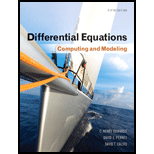
Concept explainers
(a)
Program Description: Purpose of the problem is to obtain the approximate values of
(a)
Explanation of Solution
Given information:
The differential problem is
The exact solution of the differential equation is
The two step size is
Calculation:
The differential problem can be represented as,
The Euler’s formula for
The Euler’s formula for
Substitute 0 for
Substitute 0 for
Substitute 0 for
Substitute 0 for
Substitute 1 for
Substitute 1 for
Substitute
Substitute
Therefore, the value of
Conclusion:
Thus, the approximate values of
(b)
Program Description: Purpose of the problem is to find the approximate values of
(b)
Explanation of Solution
Given information:
The differential problem is
The exact solution of the differential equation is
The two step size is
Calculation:
The improved Euler’s formula for predicators
The improved Euler’s formula for predicators
Substitute 0 for
Substitute 0 for
Substitute 0 for
Substitute 0 for
The improved Euler’s formula for correctors is shown below.
The improved Euler’s formula for correctors
Substitute 0 for
Substitute 0 for
Substitute 0 for
Substitute 0 for
Therefore, the value of
Conclusion:
Thus, the approximate values of
(c)
Program Description: Purpose of the problem is to find the approximate values of
(c)
Explanation of Solution
Given information:
The differential problem is
The exact solution of the differential equation is
The two step size is
Calculation:
The Runge-Kutta iteration formulas are shown below.
The Runge-Kutta iteration formulas are shown below
The value of
The value of
Substitute 0 for
Substitute 0 for
Substitute 0 for
Substitute 0 for
Substitute 0 for
Substitute 0 for
Substitute 0 for
Substitute 0 for
Substitute
Substitute
The exact solution
The exact solution
It can be observed that the Runge-Kutta method is more closes to the exact solution of the differential equation.
Conclusion:
Thus, the approximate values of
Want to see more full solutions like this?
Chapter 4 Solutions
Differential Equations: Computing and Modeling (5th Edition), Edwards, Penney & Calvis
- Exercise 1 Function and Structure [30 pts] Please debug the following program and answer the following questions. There is a cycle in a linked list if some node in the list can be reached again by continuously following the next pointer. #include typedef struct node { int value; struct node *next; } node; int 11_has_cycle (node *first) if (first == node *head { NULL) return 0;B = first; while (head->next != NULL) { if (head == first) { return 1; } head head->next; } return 0; void test_11_has_cycle() { int i; node nodes [6]; for (i = 0; i < 6; i++) nodes [i] .next = NULL; nodes [i].value i; } nodes [0] .next = &nodes [1]; nodes [1] .next = &nodes [2]; nodes [2] .next = &nodes [3]; nodes [3] .next = & nodes [4]; nodes [4] .next = NULL; nodes [5] .next = &nodes [0]; printf("1. Checking first list for cycles. \n Function 11_has_cycle says it hass cycle\n\n", 11_has_cycle (&nodes [0]) ?"a":"no"); printf("2. Checking length-zero list for cycles. \n Function 11_has_cycle says it has %s…arrow_forwardcheckpoint exercice for my students for Amortized Analysisarrow_forwardusing r languagearrow_forward
- using r languagearrow_forwardusing r languagearrow_forwardCompute a Monte Carlo estimate o of 0.5 0 = L ē -xdx 0 by sampling from Uniform(0, 0.5). Find another Monte Carlo estimator 0* by sampling from the exponential distribution. Use simulations to estimate the variance of Ô and ⑦*, which estimator has smaller variance?arrow_forward
- import tkint class ShowInfoGUI:def __init__(self):# Create the main windowself.main_window = tkinter.Tk() # Create two framesself.top_frame = tkinter.Frame(self.main_window)self.bottom_frame = tkinter.Frame(self.main_window)arrow_forwardJOB UPDATE Apply on- COMPANY VinkJobs.com @ OR Search "Vinkjobs.com" on Google JOB PROFILE JOB LOCATION INTELLIFLO APPLICATION DEVELOPER MULTIPLE CITIES GLOBAL LOGIC SOFTWARE ENGINEER/SDET DELHI NCR SWIGGY SOFTWARE DEVELOPMENT BENGALURU AVALARA SOFTWARE ENGINEER (WFH) MULTIPLE CITIES LENSKART FULL STACK DEVELOPER MULTIPLE CITIES ACCENTURE MEDPACE IT CUST SERVICE SOFTWARE ENGINEER MUMBAI MUMBAI GENPACT BUSINESS ANALYST DELHI NCR WELOCALIZE WORK FROM HOME MULTIPLE CITIES NTT DATA BPO ASSOCIATE DELHI NCRarrow_forwardHow can predictive and prescriptive modeling be used to measure operational performance in real-time? Do you see any potential downsides to this application? Can you provide an example?arrow_forward
 Operations Research : Applications and AlgorithmsComputer ScienceISBN:9780534380588Author:Wayne L. WinstonPublisher:Brooks Cole
Operations Research : Applications and AlgorithmsComputer ScienceISBN:9780534380588Author:Wayne L. WinstonPublisher:Brooks Cole C++ for Engineers and ScientistsComputer ScienceISBN:9781133187844Author:Bronson, Gary J.Publisher:Course Technology Ptr
C++ for Engineers and ScientistsComputer ScienceISBN:9781133187844Author:Bronson, Gary J.Publisher:Course Technology Ptr C++ Programming: From Problem Analysis to Program...Computer ScienceISBN:9781337102087Author:D. S. MalikPublisher:Cengage Learning
C++ Programming: From Problem Analysis to Program...Computer ScienceISBN:9781337102087Author:D. S. MalikPublisher:Cengage Learning


